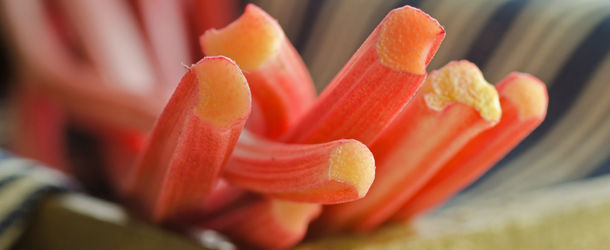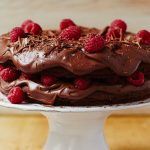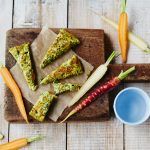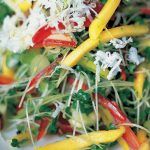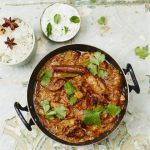By Georgie Socratous
Rhubarb is a wonderful, wonderful thing. Its brilliant colour and sharp, utterly unique flavour are what I look forward to the most in February. It’s a sign of the return of spring – of crisp blue skies, new produce and greedy Sunday lunches. But forced rhubarb is even more exciting than any of that.
It begins to creep into our shopping baskets at the beginning of the year, before normal rhubarb. Its thick stems are a slightly lighter shade than that incredible fluorescent red we all know and love – more of a speckled pink that reaches up towards yellowish leaves. It’s traditionally grown in what is called the “Rhubarb triangle” – a 9 square mile area of West Yorkshire where 90% of all winter forced rhubarb was once grown. Because of that, Yorkshire forced rhubarb was given Protected Designation of Origin (POD) status in 2010.
Yorkshire forced rhubarb is actually grown indoors – in complete darkness. The roots of the rhubarb spend around two years in the field without being harvested, where their roots store loads of energy from the sun. Once they have been exposed to a frost they are planted inside huge, dark sheds, where the warm environment inside turns all that energy into glucose and rapidly begins to grow. Apparently, if it is quiet enough inside the sheds you can hear the popping of the rhubarb being “forced” from the earth. This way of growing rhubarb produces a sweeter and far more tender taste than the later variety that is grown outside, so make the most of these beautiful creatures when they are available.
One of my favourite ways of eating forced rhubarb – or any rhubarb for that matter – is a very easy rhubarb Eton mess. I like having a glimpse of summer in my winter puddings once in a while because it gives me hope of things to come. Wash and slice about 300g-400g of rhubarb into 5cm pieces and lay neatly in a roasting tray. Scatter over the finely grated zest of a lime and a lemon, then squeeze over the juice of both. Sprinkle over 75g of golden caster sugar then pop into a low oven (about 160°C) for half an hour. The rhubarb is ready when it’s soft if pierced with a knife, but still holds its shape. Allow to cool then carefully lift the rhubarb out of the tray and set aside in a bowl. Pour the lovely fluorescent juice left in the tray into a small pan and add a splash of water and a couple of tablespoons of sugar. Place over a low heat and bubble for a minute or two to create a luxurious syrup. Taste, add more sugar if you think it needs it, but I quite like the kick of the rhubarb seasoned with just a hint of sweet.
Allow the syrup to cool then add to the bowl with the rhubarb. Gently whip a pint of double cream to very soft peaks, break in a good handful or two of crunchy meringue and carefully ripple through your rhubarb compote. Dollop into bowls and enjoy. This February feast should be enough for about six people, who will certainly come back for more.
